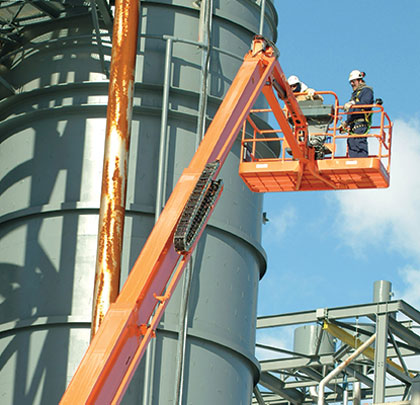Most falls involving aerial work platform (AWP) equipment can be traced to operator error and/or improper use. Reasons for falls may include:
- Occupant is not wearing required PFP equipment or is not attached to anchorage point.
- Occupant is ejected or catapulted from a boom lift when it is struck by another vehicle or object, or moves unexpectedly.
- Occupant climbs on guardrails or out of the platform.
- Occupant overreaches beyond the edge of the platform.
- Platform component failure occurs due to improper maintenance or inspection.
AWP equipment provides a safe means to access work at heights when properly maintained and operated by trained and familiarized operators who are appropriately monitored and supervised by their employers. One of the best ways to prevent fall hazards is through proper training and planning. A risk assessment of all fall hazards, even potential fall hazards, must be completed before appropriate corrective measures can be considered. A complete risk assessment of the fall hazard will include training requirements and defining rescue plans in the event of a fall.
A company’s fall protection plan for a jobsite can include the use of AWP equipment. In fact, this equipment can be used as a tool to prevent falls because AWP equipment offers a fully guardrailed platform that elevates to the work location. The use of an appropriate PFP system should be part of the plan.
Prior to the implementation of a fall protection plan, a risk assessment should be made for the safe use of the AWP equipment to prevent potential fall hazards. A risk assessment will include identifying the hazard, assigning the risk, and defining a control measure.
IMPLEMENTING A FALL PROTECTION SYSTEM
Whenever possible, eliminate fall hazards. Identify hazards that can’t be eliminated and evaluate each one. The evaluation will assist in determining appropriate personal fall protection (PFP) for the jobsite. Review the following questions and items of consideration before implementing a fall protection plan. This is not an all-inclusive list, but a few examples.
Questions to consider when implementing a fall protection plan:
- What is the fall distance from the working surface to the next lower level?
- How many operators/occupants are exposed to the hazard?
- What task and work areas are associated with the hazard?
- Are proper anchorages available?
- How will the operator/occupant(s) be promptly rescued if suspended in a personal fall arrest system?
- Does the AWP equipment operator have someone on the ground to assist in case of an emergency?
- Is the AWP equipment operator/occupant(s) trained in self-rescue techniques?
- Are there other rescue plans in place that can be applied in all circumstances?
- Has the operator/occupant(s) been trained in how to properly inspect and don PFP equipment?
- Are there changes in the equipment or the jobsite conditions that require retraining?
DO’S AND DON’TS FOR AWP FALL PROTECTION
Do:
- Ensure that only properly trained and familiarized personnel are authorized to operate AWP equipment.
- Read and understand the manufacturer’s instructions for all equipment to be used.
- Choose the correct AWP equipment to reach the work.
- Monitor the operator/occupant(s) performance and supervise the work to ensure the use, application, and operation of the AWP equipment is in conformance with the lift manufacturer’s operator’s manual and all applicable standards, regulations, and safety rules.
- Direct and monitor the operator(s)/occupant(s) of AWP equipment to ensure that each person wears PFP equipment when required.
- Ensure that only qualified personnel inspect and maintain PFP equipment.
- Ensure that each operator/occupant is properly trained.
- Immediately remove from service personal fall arrest systems or components subjected to impact loading (e.g., involved in a fall).
- Use PFP equipment only for its intended use.
- Avoid PFP equipment contact with sharp edges; ensure that all edges that PFP equipment may come in contact with are smooth, rounded, or chamfered.
- Ensure that the AWP equipment guardrail system is properly installed and positioned, and access gate(s) and opening(s) closed per the manufacturer’s recommendations.
- Operate the AWP equipment safely to avoid the risk of ejection (e.g., drop-offs, being hit by other vehicles or objects).
- Limit travel speed according to conditions.
- Always stand with feet firmly on the floor of AWP equipment.
- Assess each jobsite for potential fall hazards.
- Ensure that each operator/occupant is wearing the correct size harness.
Do Not:
- Do not overextend the upper body outside of the basket.
- Do not sit or climb on the edge of the basket or use planks, ladders, or other devices for a work position.
- Do not use guardrails or other AWP equipment components as a PFP system anchorage unless written permission from the AWP manufacturer has been obtained prior to use.
- Do not connect to adjacent poles, structures, or equipment while working from AWP equipment.
- Do not remove the guardrail or leave the gate open during use.
- Do not leave an elevated work platform or exit it and remain tied-off unless authorized by the AWP equipment manufacturer and directed by the employer.
- Do not exceed the manufacturer’s allowed rated horizontal forces when working from the platform of AWP equipment. ■
For More Information:
The Statement of Best Practices of Personal Fall Protection Systems for Aerial Work Platform Equipment was developed by the American Rental Association, the Association of Equipment Manufacturers, the Scaffold Industry Association, the Associated Equipment Distributors, and the International Powered Access Federation to provide general guidance in basic fall protection and best practices for the use of personal fall protection systems with aerial work platform equipment.
_________________________________________________________________________
Modern Contractor Solutions, May 2013
Did you enjoy this article?
Subscribe to the FREE Digital Edition of Modern Contractor Solutions magazine.



